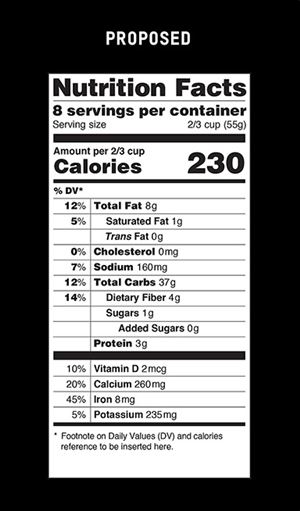
NUTRITION
FDA pushes overhaulof food-package labels
Calorie clarity, realistic servings sought
2/28/2014
Added sugars and more realistic serving sizes are among planned changes to food labels.
PITTSBURGH — Try finding “calories” on a Nutrition Facts food label. You might need a magnifying glass.
Try differentiating between natural and added sugars. You can’t.
And try calculating sugar or carbohydrate totals based on the actual rather than the stated serving size. You need a calculator.
The U.S. Food and Drug Administration announced plans on Thursday to correct these problems with proposed upgrades in the nutritional facts labels for packaged foods.
Changes include more realistic serving sizes, with “calories” in large, bold print, among other improvements based on new findings in nutritional science.
“Now they are increasing the type so you see ‘calories,’ and it prioritizes calling attention to vitamin D and potassium, which is stuff people don’t get enough of,” said Leslie Bonci, director of sports nutrition at the University of Pittsburgh Medical Center.
Ms. Bonci lauded the changes.
“There’s also a focus on what serving size people actually eat. No one is eating those [current] serving sizes,” she said. “The new labels will take away that level of ignorance and put reality into the mix.”
Nutrition facts labels have been required on packaged food for 20 years, with the most recent update in 2006 to add trans fat.
“Our guiding principle here is very simple, that you, as a parent and a consumer, should be able to walk into your local grocery store, pick up an item off the shelf, and be able to tell whether it’s good for your family,” said First Lady Michelle Obama in an FDA release. “So this is a big deal, and it’s going to make a big difference for families all across this country.”
Ms. Obama has been working with the FDA to upgrade labeling as a tool to improve health and reduce obesity.
The public has 90 days to comment on proposed requirements. Then it will take about two years for final guidelines to be issued and the industry to get upgraded labels on packaged food.
“To remain relevant, the FDA’s newly proposed nutrition facts label incorporates the latest in nutrition science as more has been learned about the connection between what we eat and the development of serious chronic disease impacting millions of Americans,” FDA Commissioner Margaret Hamburg said.
Key changes would include a new listing for grams of “added sugar” in the product. Values per serving would be amended to reflect more realistic serving sizes. A 20-ounce bottled drink, for example, would be listed as a single serving rather than 2.5 servings of 8 ounces.
New labeling also could require potassium and vitamin D levels — nutrients many Americans are deficient in. Potassium is beneficial in lowering blood pressure, the FDA officials said, and vitamins A and C would no longer be required on the label, though manufacturers could declare them voluntarily.
The FDA will revise “daily values” for such nutrients as sodium, dietary fiber, and vitamin D to reflect updated nutritional requirements. The FDA said those values help consumers understand nutrition information in the context of one’s total daily diet.
While “total fat,” “saturated fat,” and “trans fat” will continue to be listed, “calories from fat” will be removed “because research shows the type of fat is more important than the amount,” the FDA said.
The proposed format also would drive attention to serving sizes, percent daily value, and calories, because of their importance “in addressing current public health problems like obesity and heart disease.”
The FDA also has corresponding updates in the supplemental facts labeling.
Ms. Bonci said upgraded information on food labels is critically important in helping people understand and track daily nutrition.
When people see 200 calories per serving, they typically drink the entire bottle, not realizing the bottle contained 2.5 servings or 500 total calories.
“I don’t know many people who buy a 20-ounce bottle and only drink a third of it,” she said. “If you drink it, you don’t want to undershoot the level of calories.”
Upgraded labeling, Ms. Bonci said, also will help turn supermarkets into wellness centers, where people can get needed information to improve diet and nutrition.
For example, the current label includes only total sugar in grams. But the list of ingredients might show “four-syllable words” describing various forms of sugar or highly processed carbohydrates that quickly turn into glucose, such as maltodextrin. Few people understand what that is or what impact it has on health.
“But when it is listed as ‘added sugar,’ it’s easy to understand,” she said. “People can see the number and pick accordingly.”
The Block News Alliance consists of The Blade and the Pittsburgh Post-Gazette. David Templeton is a reporter for the Post-Gazette.
Contact David Templeton at: dtempleton@post-gazette.com or 412-263-1578.